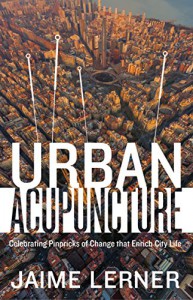The Curious Curator's Book Blog
Contemporary art curator. Student. Book addict. Art lover. Geek. Dreamer. Curious about everything. Check out my website http://thecuriouscurator.com/
Currently reading
Urban Acupuncture by Jaime Lerner

“Good acupuncture is about drawing people out to the streets and creating meeting places. Mainly, it is about helping the city become a catalyst of interactions between people. A mass transit hub, for example, doesn’t have to be just a bus station. It can also be a gathering place."
Cities are supposed to grow organically, but modernity brought with it huge migrations, and in order to accommodate the growing population and its needs, modern urban planning can be summed up in the phrase “out with the old, in with the new”. In general, it consisted in throwing people out of their traditional homes, bulldozing said homes, and build freeways and concrete apartment buildings. Over time, these cities became cities made for cars, not people. People stopped living in the urban space, leading to a dwindling sense of community. These and other reasons made life in big cities unpleasant, chaotic and lonely.
With most of the population quickly shifting to urban communities, it has become more important than ever to understand cities and to know how to make them better places to live and work in. As should be obvious to everyone, this is no easy task. In this book, Jaime Lerner, former mayor of Curitiba, Brazil, defends the idea that you don’t have to undertake large-scale changes to a city in order to make it better. You just have to pinpoint a few, small changes here and there, that will trigger a cascade of positive events in the city’s energy - hence, the acupuncture metaphor.
I began reading thinking this was a great analogy, but after a while (and a lot of repetition) I was less sure of its effectiveness. The examples he uses are interesting, but they’re also wildly different, and sometimes it’s hard to understand how it all can be brought together under the concept of “urban acupuncture”. The biggest problem for me was that the examples were a bit too superficially explored. But the book does give an overall hopeful view of the future of cities.
Jaime Lerner sounds like he was a remarkable mayor and is a talented city planner who really understands and loves urban life.
Note: I got this book for review purposes through NetGalley.









